
Feature Article
School Lunch and Food Safety
Assuring the safety of food served in schools is essential as young children are particularly susceptible to foodborne illness. Inappropriate food handling encourages the spread of pathogens and poses a potential threat to food safety. The collaborative effort of schools, meal box suppliers and parents is necessary to safeguard food safety and the health of students. This article highlights the potential hazards in the course of lunch box preparation.
Food safety of meal boxes from suppliers
Meal boxes are typically mass-produced at the supplier's food factory. Therefore, any lapse in food safety can potentially affect a large number of diners. Suppliers should plan ahead of time to ensure sufficient manpower, space, and equipment for food storage, preparation, cooking and hot-holding. Kitchens should preferably have designated working zones and different utensils for handling raw and cooked food. Comprehensive operating protocols and cleaning schedules should be in place to ensure the adoption of “5 Keys to Food Safety” and Good Hygiene Practices (GHPs).
Keeping food away from Danger Temperature Zone between 4°C and 60°C is key to producing safe meal boxes. In general, there are three major critical control points (CCPs) along the process of meal box preparation where food safety hazards can be prevented:
Cooking
Thorough cooking is a critical step to eliminate pathogens such as Clostridium perfringens that are likely to accompany any raw foods brought into a food preparation area. Foods including rice should be thoroughly cooked and reheated until its centre reaches 75°C or above. Where possible, cook all food items, including sauce and soup, on the day of consumption.
Hot holding
Prolonged storage and transport within temperature danger zone after cooking will allow bacteria to grow. Hence, finished meal boxes should be consistently kept above 60˚C in electric warming trolleys. Preheating hot-holding equipment by suitable and feasible means before putting meal boxes in it. Schools should distribute the meal boxes to students in a timely manner upon arrival.
Delivery
Controlling the temperature of food (e.g. hot food kept above 60˚C) during delivery is extremely important in ensuring that food is safe to eat, likewise shortening the delivery time as far as practicable. Insulated containers can be used to keep food consistently hot before use.
CCPs should be monitored to assess whether they are met, such as using a temperature probe to measure food temperature, followed by documentation. If the established CCP standards are not fulfilled, corrective actions such as continuing the cooking process until it reaches the target standard in order to bring the process back into control.
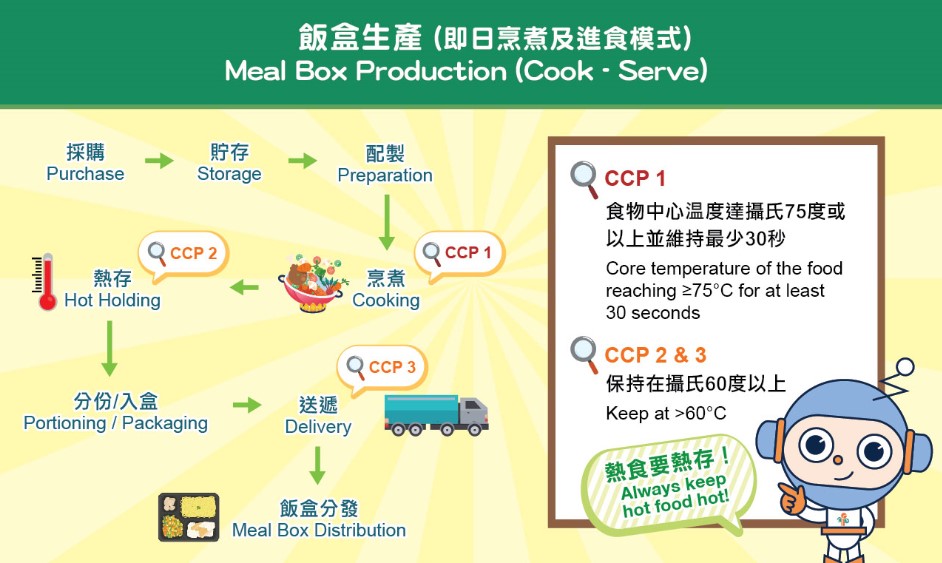
Figure 1: Schematic diagram for meal box production
Meal produced at school canteens
Schools with in-house kitchens should also observe the aforementioned practices when preparing and serving meals. Cross-contamination and lapses during portioning are two major concerns when meals are prepared on campus. The use of the same equipment for handling raw and ready-to-eat foods may result in contamination after cooking. To prevent cross-contamination, food handlers should wash hands regularly, and change gloves between preparing foodstuffs or when soiled. Utensils for different purposes and areas should be clearly labelled. Environmental hygiene of dining areas such as canteens should also be well maintained. It is often best to follow a ‘clean as you go’ approach while preparing food; trash should be properly disposed of after each meal to avoid pest infestation.
When giving out food to students, it should be done in a designated area with enough space, and staff handling the meals should observe personal hygiene. Portioning utensils and tableware provided to students should be clean and kept in good condition. Hot-holding devices should be available in order to keep meals at a temperature above 60°C.
Precautions when bringing home-made meal boxes
When choosing to pack lunches for their children, parents should keep the “Five Keys to Food Safety” in mind. Pre-cooked food should be thoroughly reheated and kept at safe temperatures by storing them in appropriate insulated containers. Students should wash their hands thoroughly before tucking in. In order to create a safe and healthy environment at school, food handlers should always maintain personal hygiene and have a basic understanding of food hygiene and temperature control, regardless of how the school meals are prepared.
Mascot ON in Lesson
Scombrotoxin Fish Poisoning
In October 2022, the Centre for Food Safety (CFS) received notification from the Centre for Health Protection of a suspected scombrotoxin fish poisoning (SFP) case involving tuna fillet, and took samples of the incriminated food for testing. Test results showed that a frozen tuna fillet sample contained histamine at a level which can cause foodborne intoxication. As instructed by the CFS, the importer, supplier and restaurant concerned stopped selling and discarded the product in question. The importer initiated a recall as well. The CFS observes a slight increase in SFP cases in Hong Kong, with one, two and four cases in 2020, 2021 and 2022 (as at November 2022) respectively, compared to no recorded cases in 2018 and 2019.
What is Scombrotoxin Fish Poisoning?
SFP, also called “histamine poisoning”, is caused by ingestion of fish containing high levels of histamine. The fish species involved in SFP include tuna, sardines, anchovies, mahi-mahi, herring, marlin, bluefish, salmon, yellowtail and swordfish, which usually contain high levels of the amino acid histidine in their tissues. If the fish is handled and stored at an inappropriate temperature after harvesting, some of the bacteria that are part of the natural microflora of the fish will multiply. The bacterial enzyme, histidine decarboxylase, converts histidine into histamine (Figure 1), which can be formed along the food supply chain from harvesting to consumption of the fish. Other biogenic amines produced as a result of bacterial growth in fish may potentiate the toxicity of histamine.
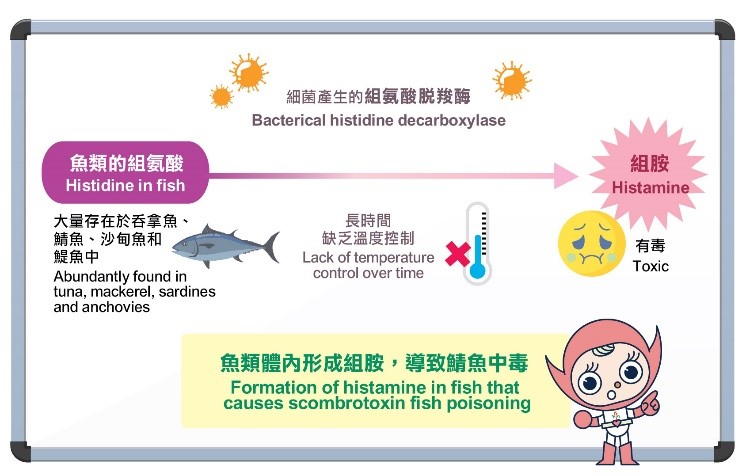
Figure 1: Formation of histamine in fish due to temperature abuse
Although heat treatments, such as cooking and hot-smoking, can kill histamine-producing bacteria and inactivate histamine-producing enzyme, histamine by itself is very heat-stable. Once formed, histamine cannot be destroyed by cooking, canning or freezing. Though histamine-contaminated fish may have a metallic off-flavour, a bad odour and a discoloured appearance, some of the fish may look, smell and taste normal. Therefore, it is not possible to rely on sensory assessment to ascertain the absence of histamine in fish.
Symptoms of Scombrotoxin Fish Poisoning
Individuals suffering from SFP may show one or more symptoms including tingling and burning sensation around the mouth, facial flushing, sweating, nausea, vomiting, headache, palpitation, dizziness and rash. Symptoms typically develop rapidly, from five minutes to two hours after consumption of the contaminated fish, usually lasting 8 to 12 hours. Although SFP symptoms may persist for up to several days, there are no known long-term sequelae. SFP is considered to be rarely, if ever, fatal.
Risk Assessment of Histamine
According to the Food and Agriculture Organization of the United Nations/World Health Organization, a person exposed to more than 50 mg of histamine may exhibit symptoms of acute histamine intoxication. No cumulative effect of consecutive meals containing fish is expected, because histamine usually leaves the body within a few hours.
Preventive Measures for Scombrotoxin Fish Poisoning
High histamine levels are a result of bacterial action due to temperature-time abuse where fish and fishery products are handled or stored at an inappropriate temperature over a prolonged period of time. As such, fish should be chilled immediately after death, and the cold chain integrity should be maintained throughout the process from harvesting to consumption. Chilled fish and fishery products should be kept at 4°C or below, while frozen products at - 18°C or below (Figure 2). Cooked fish and ready-to-eat fish products (e.g. tuna sandwiches and opened canned fish) may be re-contaminated by histamine forming bacteria, and should be kept under refrigeration if they are not consumed immediately. Do not defrost frozen fish at room temperature in order to prevent histamine production. Instead, frozen products should be defrosted properly by, for example, making use of a refrigerator compartment, putting the fish under running tap water or thawing it in a microwave oven.
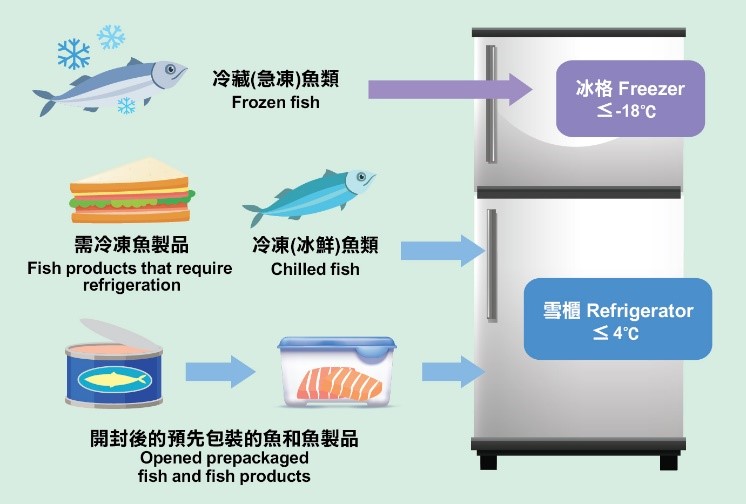
Figure 2: To prevent SFP, fish and fish products should be kept at an appropriate temperature
The CFS has issued a Food Safety Advice on Prevention of Scombrotoxin Fish Poisoning, detailing the preventive measures of SFP for traders and consumers.
Key Points to Note
- SFP is caused by eating fish containing high levels of histamine.
- Histamine is heat-stable and will not be affected by cooking, canning or freezing.
- High histamine levels in fish and fishery products are a result of temperature-time abuse during handling and storage.
Advice to the Public and the Trade
- Purchase fish and fishery products from reliable and hygienic sources. Do not purchase or eat fish with any sign of spoilage, such as off-odour, texture breakdown and discoloured flesh.
- Chilled fish and fish products should be kept at 4°C or below, while frozen products at - 18°C or below.
- Frozen products should be defrosted properly, and never at room temperature in order to prevent histamine production.
Spot Check
Oysters: Know the Microbiological Risk and Eat Safely
The CFS investigated four food poisoning cases associated with the consumption of raw oysters in November 2022, with two cases involving a total of six people who dined at a restaurant, one case involving 10 people at another restaurant, and one case involving 23 people who attended a banquet. The affected persons had gastrointestinal symptoms such as abdominal pain, diarrhoea, nausea, and vomiting.
The CFS has all along been educating the public on the risks of eating raw oysters. However, raw oysters are gaining in popularity among local people as reflected from our Food Consumption Survey. Meanwhile, there has been an increase in the number of local food poisoning cases related to raw oysters in recent years, with over 100 cases in 2021, compared to an average of around 25 cases per year between 2016 and 2020. Consumers should be aware of the inherent food safety risks of raw oysters as raw oysters have not been heat-treated to kill harmful microorganisms.
Microbiological Risks of Oysters
Oysters are filter-feeders and concentrate microorganisms in seawater. They are prone to contamination by harmful microorganisms such as Vibrio bacteria, norovirus and hepatitis A virus. Further, people can contract microorganisms with antimicrobial resistance (“superbugs”) through eating raw or undercooked oysters. Whether or not “superbugs” have caused illnesses, they may transfer their antimicrobial resistance genes to other bacteria inside the human body, therefore affecting the effectiveness of future use of antibiotics when needed.
To date, there is no technology that can ensure that raw oysters are completely free of microbiological hazards. Imported raw oysters harvested in areas monitored for faecal contamination were occasionally tested positive for norovirus by overseas authorities or found to be linked to local and overseas food poisoning outbreaks. Although the majority of the affected persons have self-limiting diseases, consuming raw oysters may lead to serious health consequences, especially in vulnerable people like pregnant women, young children, the elderly, and immunocompromised people.
To minimise the risk of food poisoning, it would be best if oysters are cooked thoroughly until the core temperature reaches 90°C for 90 seconds. Treating raw oysters with hot sauce, lemon juice, vinegar or alcohol cannot kill the harmful microorganisms. Some tips on cooking oysters are given below (Figure 3):
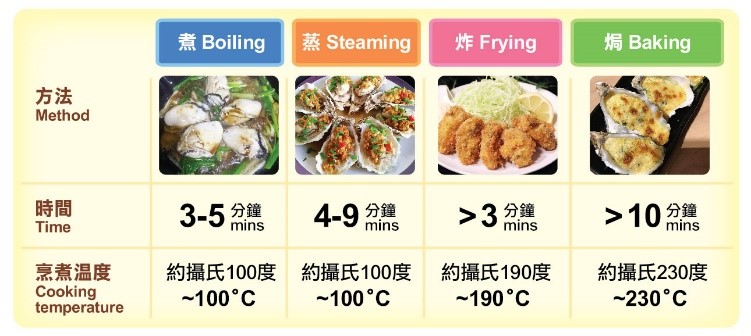
Tips for cooking oysters thoroughly
Reducing the Risks When Choosing to Eat Raw
Even though some people are aware that eating raw oysters can be risky, they still prefer to do so. In this case, actions should be taken to reduce the microbiological risk.
Whether eating out or at home, consumers should patronise reliable food premises with relevant endorsement/permits. If you choose to eat raw oysters, stick to those that are meant for consuming raw. When purchasing live oysters in person, choose fresh and intact oysters whose shell should be shut or should close when tapped lightly. When ordering delivery, check the general condition of the oysters upon receipt, such as the temperature, the hygiene conditions and the integrity of the container. Before shucking, discard dead oysters and those with slimy surface, in a dripping state or of dull colour.
To stay away from the Temperature Danger Zone in which bacteria like Vibrio parahaemolyticus can grow and thrive rapidly, it is essential to keep the oysters cool at 4°C or below all the way before consumption. Oysters should be put on edible ice cubes to keep cool and eaten immediately after shucking.
Food handlers should prevent cross-contamination of foods during storage and handling of oysters by keeping oysters in a covered container in the refrigerator, and should always practise good hygiene, including washing hands, using clean utensils, and washing and scrubbing the shells when handling oysters, and use clean, protective gloves and sterilised oyster shucking knives when shucking oysters to prevent injury and infection. Still, these measures are not fail-safe; without thorough cooking, the risk of infection from eating raw oysters cannot be eliminated.
To enhance food safety and allow consumers (especially susceptible individuals) to make informed choices, the CFS has issued new food safety advice on the food safety risks of raw oysters to the public and provided a set of guidelines for the trade to help food businesses implement appropriate and practical food safety measures when serving oysters to be eaten raw. Both the public and food businesses are urged to take the necessary precautions when eating or serving raw oysters.
Safe Kitchen/Trade Talks/Food Safety Guidelines
Safe Kitchen
Introduction to “Safe Kitchen” Scheme
To facilitate the adoption of the "5 Keys to Food Safety" and good hygiene practices by trade members, and enhance food safety in their daily operation, the CFS has integrated the existing channels of risk communication and launched a new platform, namely "Safe Kitchen", to communicate with the trade. The platform provides food safety information of greater practical importance to meet the operational needs of catering outlets.
The "Safe Kitchen" platform disseminates up-to-date food safety information (including food safety guidelines and relevant legislative amendments) to the trade through a host of channels including WhatsApp, emails and dedicated websites. In response to food poisoning outbreaks in restaurants, the platform will also issue food alerts to remind the trade of the points to note in preventing future occurrences so that the risk of food poisoning can be minimised.
New dedicated websites and risk information exchange platforms will be rolled out under the "Safe Kitchen" Scheme. In addition, training materials tailor-made for the trade and workshops for kitchen staff will be provided to enhance food safety and hygiene awareness among them. Members of the trade are welcome to scan the QR code on the left to download the registration form for the "Safe Kitchen" Scheme in order to receive the latest food safety information in a timely manner.
Trade Talks
Trade Talks 2023
The CFS will organise food safety talks and workshops on Good Hygiene Practices (GHPs) for Food 2023 from April through November to publicise proper food handling to employees of food businesses, with a view to promoting GHPs through active participation from the trade and its collaboration with the government, and encouraging the development of a Food Safety Plan in food processing, thereby enhancing food safety.
The talks will be conducted in Cantonese. Participants will be awarded a certificate of attendance. Details can be found under “What's New” on the CFS's website.
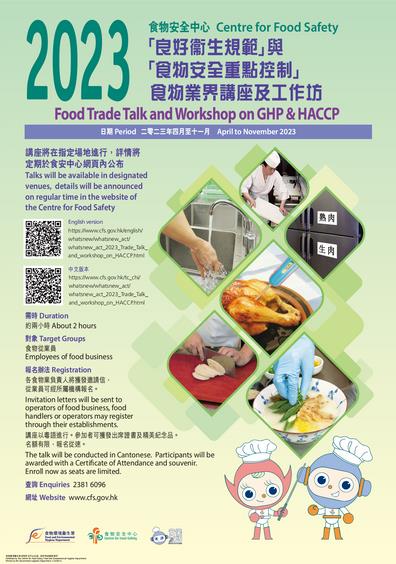
Chinese website: <https://www.cfs.gov.hk/tc_chi/whatsnew/whatsnew_act/whatsnew_act_2023_Trade_Talk_and_workshop_on_HACCP.html>

English website: <https://www.cfs.gov.hk/english/whatsnew/whatsnew_act/whatsnew_act_2023_Trade_Talk_and_workshop_on_HACCP.html>

Food Safety Guidelines
Oysters Intended for Raw Consumption - Food Safety Guidelines for Food Businesses
As oysters and other shellfish are filter-feeders that concentrate microorganisms in sea-water, they are easily contaminated by viruses (e.g. Hepatitis A and Norwalk-like viruses). Consumption of undercooked oysters contaminated with viruses may result in illness caused by viral infection.
Ensuring food safety relies on tripartite collaboration among the food trade, the general public and the government. It is incumbent on the food trade to ensure food for sale is fit for consumption. To ensure consumers’ food safety, food handlers should always stay vigilant. In the preparation of oysters (e.g. deep-fried oysters, braised oysters with ginger and spring onion, and braised oysters with port), food handlers should observe environmental and utensil hygiene, and keep in mind the food safety risks and precautions.
In view of this, the CFS published a pamphlet, namely “Oysters Intended for Raw Consumption - Food Safety Guidelines for Food Businesses”, which covers the trade's GHPs in sourcing, receiving, storing, preparing and delivering raw oysters for reducing risks of contamination. The pamphlet also provides safe ways to cook oysters.
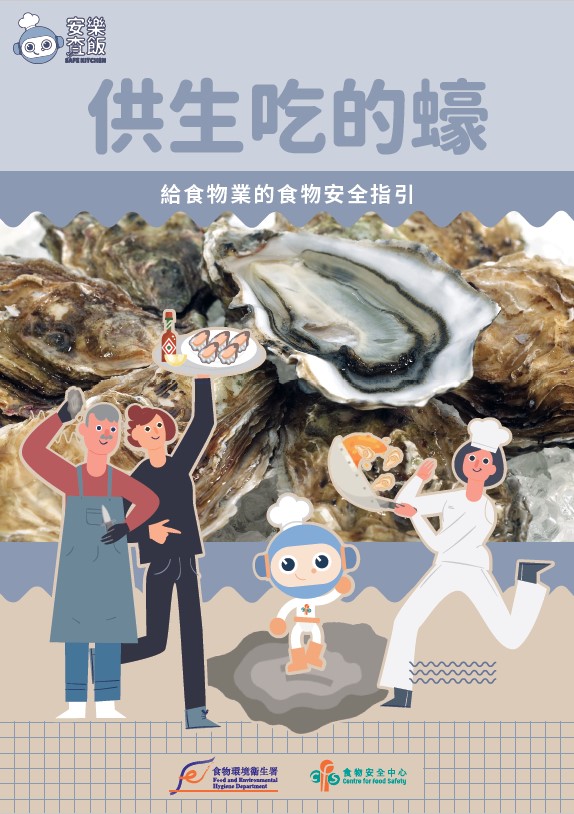
Members of the trade can browse or download the guidelines by clicking the following link or scanning the QR code next to it.
 shorturl.at/cQST3
shorturl.at/cQST3
News on CFS
1. Trade Talks on “Food Safety: High-Risk Food (Raw Oysters)
With the festival around the corner, some restaurants would solicit customers with raw oysters. However, the CFS noticed that there had been several food poisoning incidents associated with the consumption of raw oysters, a high-risk food, in restaurants in Hong Kong. The CFS therefore held two online talks on “Food Safety: Serving High-Risk Food (Raw Oysters)” on 16 December 2022 and 5 January 2023 for restaurants serving raw oysters to explain how to follow GHPs and the principles of the Hazard Analysis Critical Control Point (HACCP) system in handling raw oysters, with a view to enhancing food handlers’ understanding of food safety so that customers can enjoy their food with ease of mind during the festival.
The talks also shed light on the results of a study conducted earlier by the CFS on serving raw oysters by food premises. The study aims to formulate relevant food safety guidelines to help the trade understand the risks involved in consuming raw oysters and take appropriate and feasible food safety measures in operation, thereby reducing risks of foodborne diseases and allowing high-risk consumers to make informed choices.
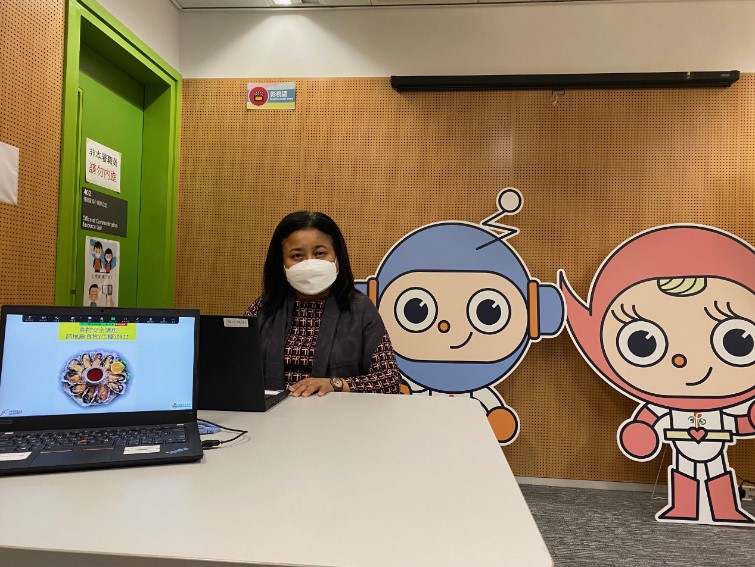
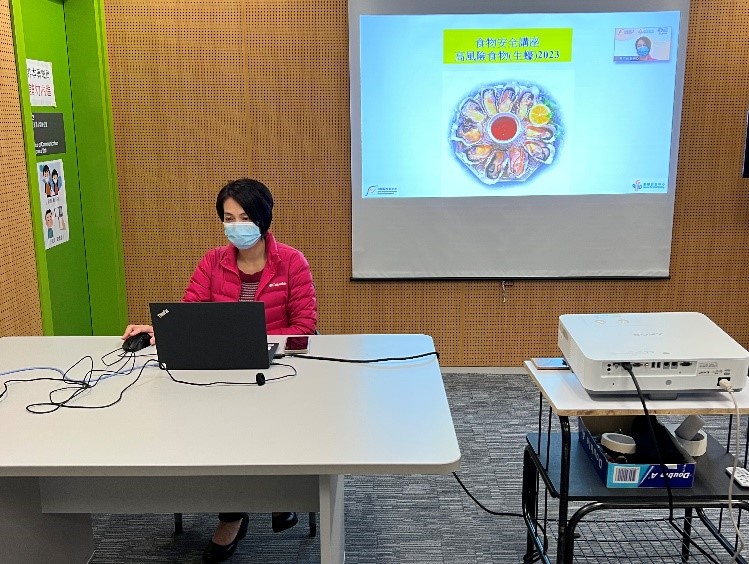
2. The 79th meeting of the Trade Consultation Forum
The 79th meeting of the Trade Consultation Forum was held on 23 December 2022. The CFS and the trade exchanged their views on topics including “Ethylene Oxide in Food”, “Takeaways and Food Delivery Guidelines”, “Colour Naturally Present in Edible Fruits or Vegetables”, “Food Safety Guidelines for Food Businesses on Oysters Intended for Raw Consumption”, “An Application Guide for Export of 18 Categories of Food Products to the Mainland”, “Food Traders’ Registration” and “Expedite the Processing of Import Licence Applications for Frozen Meat and Poultry”. For details, please visit:
https://www.cfs.gov.hk/english/committee/Notes_and_Presentation_Materials_TCF79_20221223.html

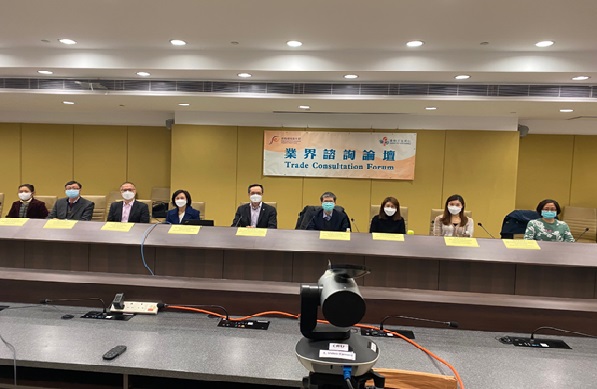
3. The Harmful Substances in Food (Amendment) Regulation 2021 Coming into Force in Phases in 2023
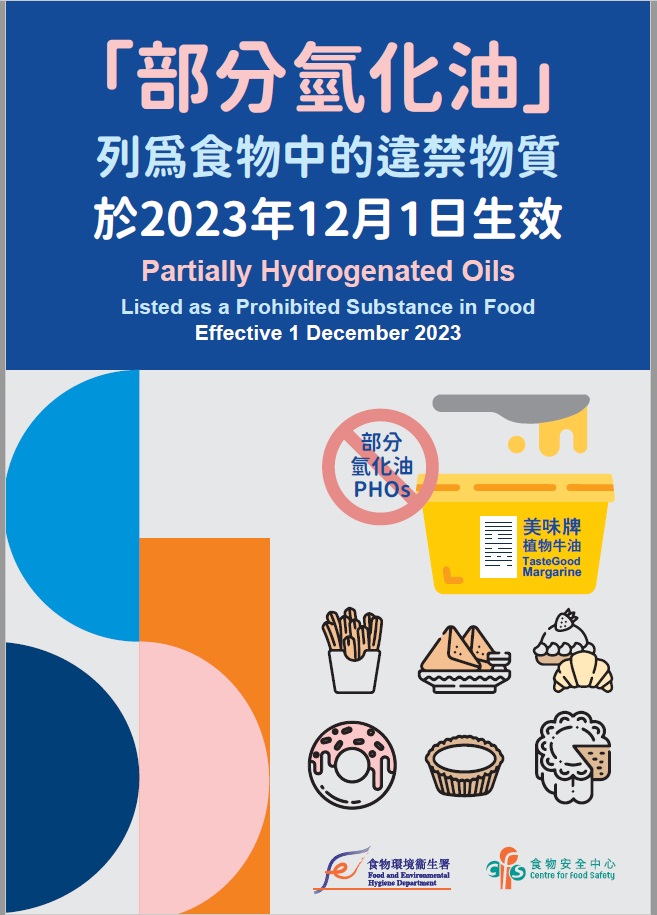
Passed in July 2021, the Harmful Substances in Food (Amendment) Regulation 2021 (“the Amendment Regulation”) aims at strengthening the regulatory control of mycotoxins in food; as well as setting or updating the maximum levels for other harmful substances in edible fats and oils, condiments or formula products intended for infants. With reference to the recommendation of the World Health Organization, the Amendment Regulation also specifies partially hydrogenated oil, i.e. the main source of industrially-produced trans fatty acids (IP-TFAs), as a prohibited substance in food, which enables the elimination of IP-TFAs at source, thereby protecting public health.
The provisions of the Amendment Regulation relating to specifying the maximum levels of mycotoxins and other harmful substances in food will come into force on 1 June 2023, while those relating to specifying partially hydrogenated oil as a prohibited substance and the related labelling requirements on 1 December 2023. The trade should ensure that food for sale complies with statutory requirements. They should also manufacture healthier food by reducing trans fats and replacing IP-TFAs in food. Consumers are advised to maintain a balanced diet and consume more vegetables.
To assist the trade in reducing trans fats in food and replacing IP-TFAs, the CFS has published a pamphlet, namely “Guidance to Replace Industrially-produced Trans Fats in Food”, to explain the Amendment Regulation to the trade.
English Version: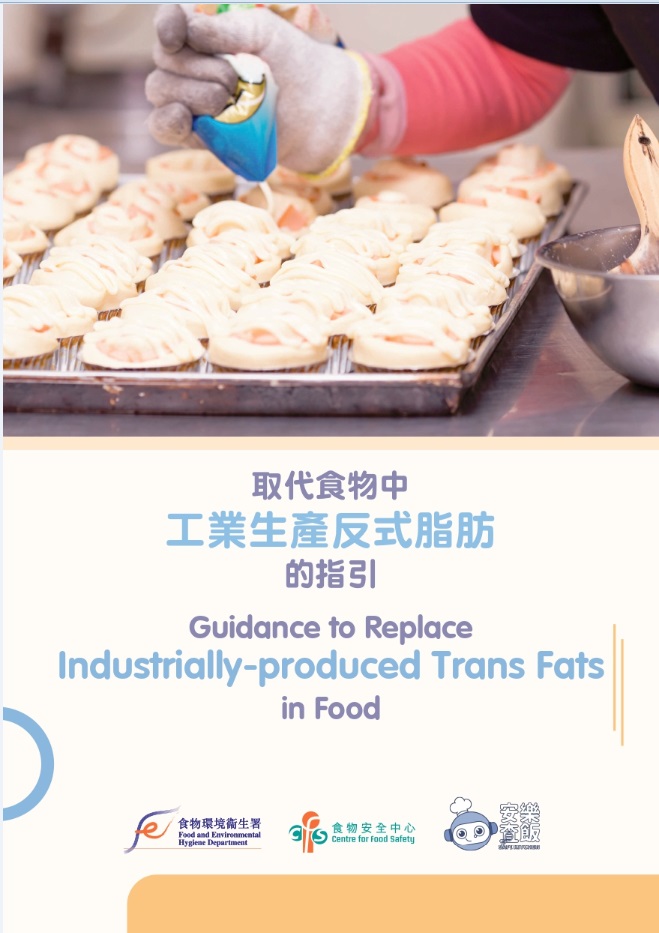
In addition, the CFS produced posters and pamphlets on “Replacing Industrially-produced Trans Fats in Food” to remind members of the public that partially hydrogenated oil will be specified as a prohibited substance in food starting from 1 December 2023. Posters and pamphlets in other languages (including English, Bahasa Indonesia, Hindi, Nepali, Tagalog, Thai and Urdu) are now available and have been distributed to relevant institutions and the trade.
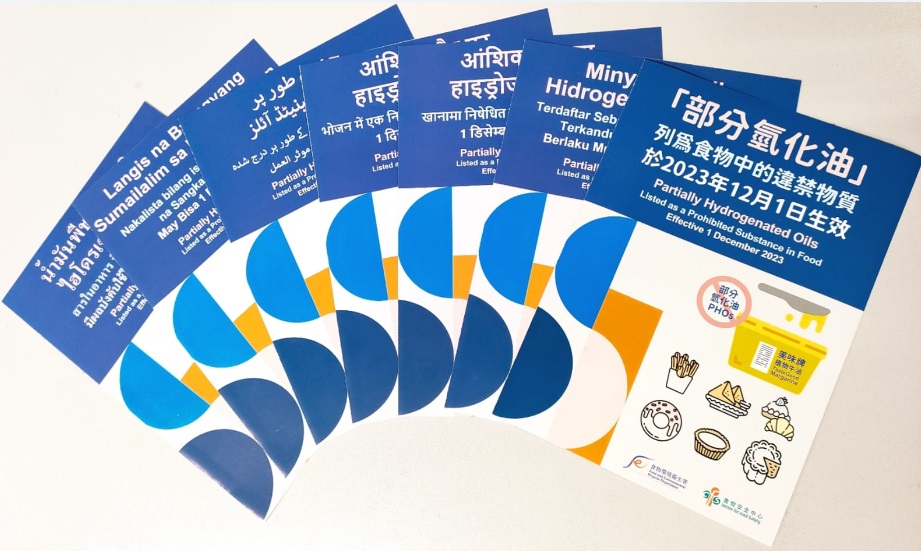

For details, please visit:
https://www.cfs.gov.hk/english/whatsnew/whatsnew_fstr/whatsnew_fstr_Food_Regulations_Harmful_Substances.html
4. Food Safety Talk on Student Lunch Boxes
With the relaxation of the anti-epidemic measures, schools have gradually resumed full-time face-to-face classes and arranged meals for students on campus since this February. However, a suspected case of food poisoning occurred after a student had a lunch box on campus. The Food and Environmental Hygiene Department (FEHD), in a joint effort with the CFS and the Education Bureau, arranged several meetings with the lunch box caterer concerned to follow up on the issue of food quality of school lunch boxes. On 20 February, the CFS took a further step and visited the food factory of the lunch box caterer concerned with the Centre for Health Protection to learn more about the production process and explain to the factory staff how to follow GHPs and the principles of the HACCP system when supplying lunch boxes.
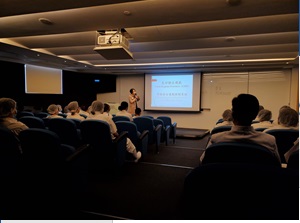
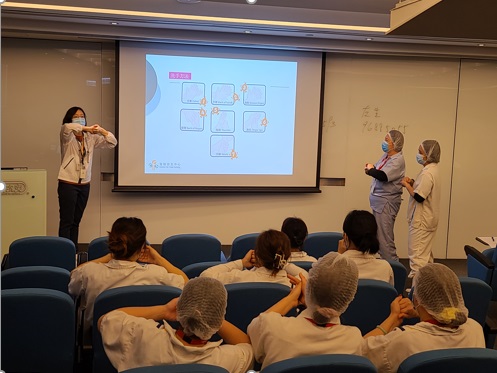
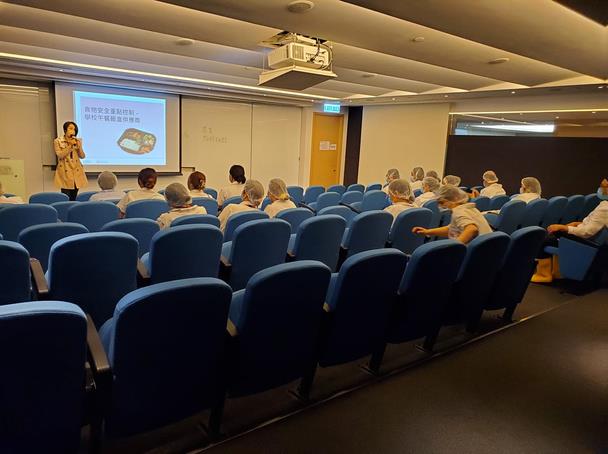
Moreover, the CFS wrote to schools and lunch box caterers earlier on, drawing their attention to the food safety of student lunch boxes. An online trade talk was also held on 25 February to remind lunch box caterers to adopt GHPs in food preparation and follow the principles of the HACCP system in drawing up a Food Safety Plan.
Ask Our Mascots
Dispelling Food Safety Myths – Colour Seepage in Purple Sweet Potato
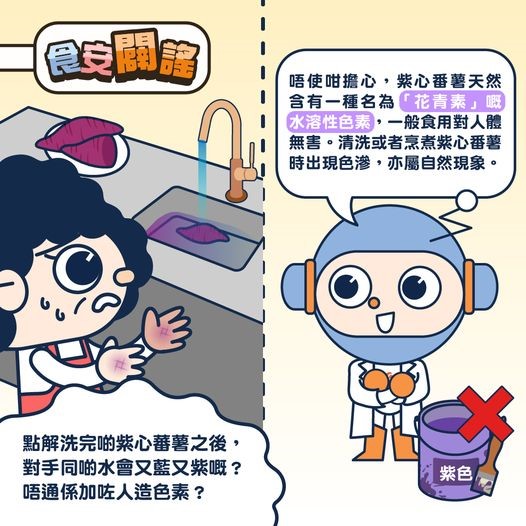
Mrs TAM: Recently, I’ve seen some gorgeous purple sweet potatoes at the market, so I bought some home. Who would have thought that after washing them, both my hands and the water turned bluish purple? Could this mean that… artificial colour has been added?
ON: No worries! In fact, purple sweet potatoes contain a naturally occurring and water-soluble colour called anthocyanin, which is commonly found in a lot of fruits and vegetables, such as grapes, purple cabbages and berries, and is generally innocuous for human consumption. In general, it is a natural phenomenon that when fruits and vegetables are washed or cooked, colours naturally present in them (e.g. anthocyanins in purple sweet potatoes and purple cabbages; lycopenes in tomatoes; and carotenes in carrots) will exude.
MUI: But of course, you should take note of the following key points to avoid any pitfalls when buying food such as fruits and vegetables:
- Purchase food from reliable shops and do not patronise unlicensed on-street hawkers;
- Avoid as far as possible food with abnormally intense colour and sold at an excessively low price;
- When cooking, check if the food colour remains abnormally intense; and
- Do not buy or consume any food when in doubt.
For more information: https://bit.ly/3yjEIV7
Knowledge Improvement Quiz
- Disease-causing microorganisms grow rapidly in food when takeaways and delivered meals are kept within the Temperature Danger Zone for a prolonged period. What is the range of the Temperature Danger Zone?
- What is the minimum temperature (°C) at which hot food should be kept throughout the process from preparation to delivery?
- What disease may arise from the consumption of red swamp crayfish or freshwater fish?
Answers:
- 4°C to 60°C
- 60°C
- Rhabdomyolysis
Diary of Mascot ON
The Battle Against Red Swamp Crayfish
Mr TAM (Crayfish Alien): I am going to conquer the earth today with my Crayfish army!
ON: MUI, in the past, there were global cases of Rhabdomyolysis after the consumption of red swamp crayfish or freshwater fish. The possible cause is an unknown heat-stable toxin that accumulated in the crayfish or freshwater fish. Symptoms of Rhabdomyolysis include muscle breakdown, muscle weakness, muscle pain, muscle rigidity, dark brown urine and kidney damage.
MUI: ON, to combat these crayfish, we should take note of the following:
❗️Purchase or consume red swamp crayfish from reputable and reliable shops;
❗️Do not consume red swamp crayfish from unknown sources or catch wild red swamp crayfish;
❗️Clean red swamp crayfish before cooking and cook thoroughly;
❗️Do not overindulge in red swamp crayfish;
❗️Do not consume the heads and internal organs of red swamp crayfish; and
❗️If you have generalised or localised muscle pain after eating red swamp crayfish, you should seek medical treatment immediately and tell the doctor about your food consumption history.
For further investigation: https://bit.ly/3B8NF59
